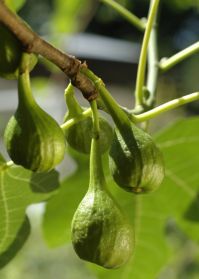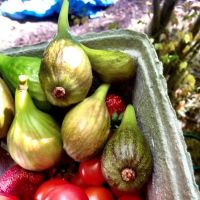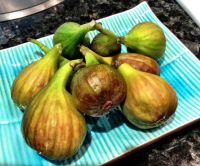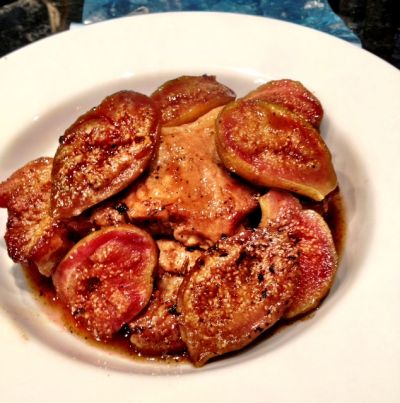 Consider the fig. It’s one of those mystical fruits steeped in history, yet sometimes relegated to being the dried, sticky filling in a stodgy Fig Newton. The fresh fig is something that should be very celebrated, as I demonstrated today on CBC Radio’s All Points West program with Jo-Ann Roberts.
Consider the fig. It’s one of those mystical fruits steeped in history, yet sometimes relegated to being the dried, sticky filling in a stodgy Fig Newton. The fresh fig is something that should be very celebrated, as I demonstrated today on CBC Radio’s All Points West program with Jo-Ann Roberts.
I still come across grown adults from time to time who have never tasted a fresh fig. I have even had to try really hard to get people to try a fresh fig, especially when I tell them that you can just bite into the whole thing, and the only part of it you won’t want to eat is the stem.
I can’t remember exactly the first time I ate a fresh fig, but I do think it was probably when I first started visiting Vancouver during the 1980’s and 90’s. So, I was in my 20’s and had only ever had Fig Newtons and some dried figs in the Christmas pastry my aunt used to make that I never liked. So a fresh, ripe fig was a revelation to me, the bright pinkish-red interior, the gentle purply-green skin, and a sweet, juicy flavour that’s different to all the other fruits out there.
I wanted to talk about figs this week because the figs on my tree at home in Cobble Hill are finally ripening, and when I posted the picture on the left to my Facebook page I got 28 likes! I was looking back at some other writing I’ve done about my figs about six years ago, when they were ripening in mid-to-late August, so I’m convinced these cool, wet springs we’ve had the past couple of years has pushed the ripening time until mid to late September now. I know there are people further south of me who have already been picking, so there must be something with the microclimate of my area and perhaps the positioning of my tree as well, although it does enjoy a lot of direct sunlight through the summer.
You can buy fresh figs in stores from time to time, but those aren’t usually local figs. Grocery store figs are usually trucked up from California, both green and black figs, usually quite pricy, and easily bruised. Sometimes I see people selling figs at farmers markets, but there’s nothing like having your own tree, or a friend or neighbour with a tree who is willing to share or doesn’t know what to do with them! People do love their fig trees, though, I remember when I used to live up in the northwest, I interviewed a man from Kitimat who had come to Canada by way of the Azores Islands, and he wasn’t willing to give up his figs that easily grew in that warm climate. So he planted a fig tree, and in the late fall, after the harvest, he would carefully bend the branches of that fig tree over as far as he could, then bury them in soil to protect it from the cold weather and metres of snow you can get in Kitimat. Then, dig it out in the spring and let it start growing and producing again.
Time to eat. First of all, if you are doing the picking yourself, and you want to just eat them plain, wait as long as possible before you pick them. This is for the green Desert King fig, which seems to be the most prevalent variety around here. Look for cracks in the skin so you can see the pinky flesh underneath, or a few drops of nectar dripping from the bottom, then you can just pick it and eat it right away! But if they are still a little under-ripe and you want to cook them, I made a couple of super easy recipes from Nigel Slater today. The first was a recipe he published in the Guardian newspaper this week, pork chops and figs braised together in what becomes a marvelous butter/apple cider sauce.
All you do is season two pork chops and brown them well in a fry pan in which you have melted some butter. Add 4 figs, halved, and a cup of dry apple cider. Reduce heat and simmer for five minutes, then take off the lid and reduce the liquid by half. So tasty! The other Nigel Slater recipe is from his Tender, Vol. 2 cookbook. Stem 8 figs, then make two crosscuts down the centre, but not all the way through. Push the figs open with your finger and place them in a baking dish. Sprinkle them with Demerara sugar and a glass of Marsala wine and roast in the oven at 400 F for about 20-25 minutes or until they start to caramelize a bit around the edges. Today I served this soft, gooey mess with a nice thick Greek-style yogurt.
 But wait, there was more! Fig/Marsala ice cream and gingerbread fig/Marsala ice cream sandwiches made by Autumn Maxwell of Cold Comfort. These products had the rest of the crew at CBC Victoria crowded around the reception desk with spoons, knives, forks, anything they could use to scoop up Autumn’s incredibly tasty treats. You can find the fig ice cream and some of her other great offerings at various shops around Victoria, just visit her website to see the list of locations.
But wait, there was more! Fig/Marsala ice cream and gingerbread fig/Marsala ice cream sandwiches made by Autumn Maxwell of Cold Comfort. These products had the rest of the crew at CBC Victoria crowded around the reception desk with spoons, knives, forks, anything they could use to scoop up Autumn’s incredibly tasty treats. You can find the fig ice cream and some of her other great offerings at various shops around Victoria, just visit her website to see the list of locations.
If you’d like to grow your own fig tree in the south Vancouver Island area, here’s a great page of advice from Victoria Master Gardener Association.
And if you missed my on the radio and would like to listen to Jo-Ann’s reaction to the food I brought in, you should be able to find the audio file of our chat on the All Points West food page.
Update: Since this item first aired on the radio I’ve had lots of remarks about it and Jane Brown, one of the commenters below, has passed on her recipes for Fig Jam and Fig Chutney. They both look good, and since I have some fig jam left from last year’s canning, I think the chutney is the recipe for me!
Fig Chutney (courtesy Jane Brown)
Ingredients
1.5 kg Black figs quartered (or any figs can be used)
1 kg sugar
3 onions chopped roughly
500g mixed raisins and sultanas
1 litre good quality red wine vinegar or plain white vinegar
2 teaspoons cayenne pepper
2 teaspoons paprika
2 teaspoons ground ginger
2 teaspoons allspice
2 tablespoons chilli sauce (I used Thai sweet chili sauce)
6 garlic cloves crushed
salt and pepper
• Wash and rinse jars and lids. Heat jars in oven at 200 deg. to sterilize. Heat rubber-ringed lids in boiling water. Simmer until ready to use to keep sterile.
• Place all ingredients together and bring to the boil, then simmer for 2 hours till good chutney consistency (fairly thick). Stir constantly to prevent sticking.
• Ladle into hot sealer jars, and place lids immediately.
• This chutney improves with age.
*Don’s note: I don’t like the taste of ground ginger so I will probably substitute some freshly grated ginger. You may also wish to treat your jars to a boiling water bath to ensure a proper seal. For proper boiling water bath procedures visit the Bernardin website.
Fig Jam (Courtesy Jane Brown)
Ingredients
Fresh figs – about 2 dozen medium to large figs (about 5 lbs) makes 7 jars (8 ounces each) of jam.
Lemon juice – either fresh squeezed or bottled – 1/4 cup.
Water – 1/2 cup
Pectin – 2 pkts.
Sugar – About 4.5 cups of dry, granulated (table) sugar.
Salt – a pinch.
Also optional: add ½ cup of brandy or 2 tablespoons Grand Marnier for a richer flavour.
Or add: ¼ teaspoon ground ginger, ¼ teaspoon ground cloves and ¼ teaspoon cinnamon
Equipment
Large heavy-bottomed pot; jam funnel; ladle; tongs; 7 or 8 canning jars (each 8 oz.)
• Wash and rinse jars and lids. Heat jars in oven at 200 deg. to sterilize. Heat rubber-ringed lids in boiling water. Simmer until ready to use to keep sterile.
• Gently wash fruit in plain, cold water. Cut off stems and bottom of figs, (Not necessary to peel). Chop into pieces (1/4s?) Should be approx. 7 to 8 cups (maximum 8 cups).
• Mix together the figs, pectin, water and lemon juice in heavy-bottomed pot on stove and heat to boiling.
• When jam has reached a full boil, add sugar and bring back to a boil. Boil hard for 1 minute.
• Skim excess foam (leaving in jam will result in a less clear product.) Save foam as you can enjoy as a taste treat! Some people add 1 teaspoon of butter or margarine to the jam mix, but food experts say that may contribute to earlier spoilage of the jam.
• Test for “jell” (thickness) using a metal tablespoon cooled in a glass of ice water. Take a half spoonful of the cooked jam and let it cool to room temperature on the spoon. If it does not thicken, then jam is not ready, so mix in a little more pectin (about 1/3 to 1/2 of another package) and bring it to a boil again for 1 minute.
• Let stand for 5 minutes then stir completely to prevent fruit from floating to the top of the jar.
• Remove jars from oven and using a jam funnel, ladle jam into hot jars. Using clean, damp cloth, wipe any spilled jam from edges of jars. (I usually fill and cap two at a time.)
• Using tongs, remove rubber ringed lids from boiling water and place on jars, tightening down with metal screw rings right away.
• Now you can enjoy listing to the “pops” when each jar lid seals as the jam cools off!



